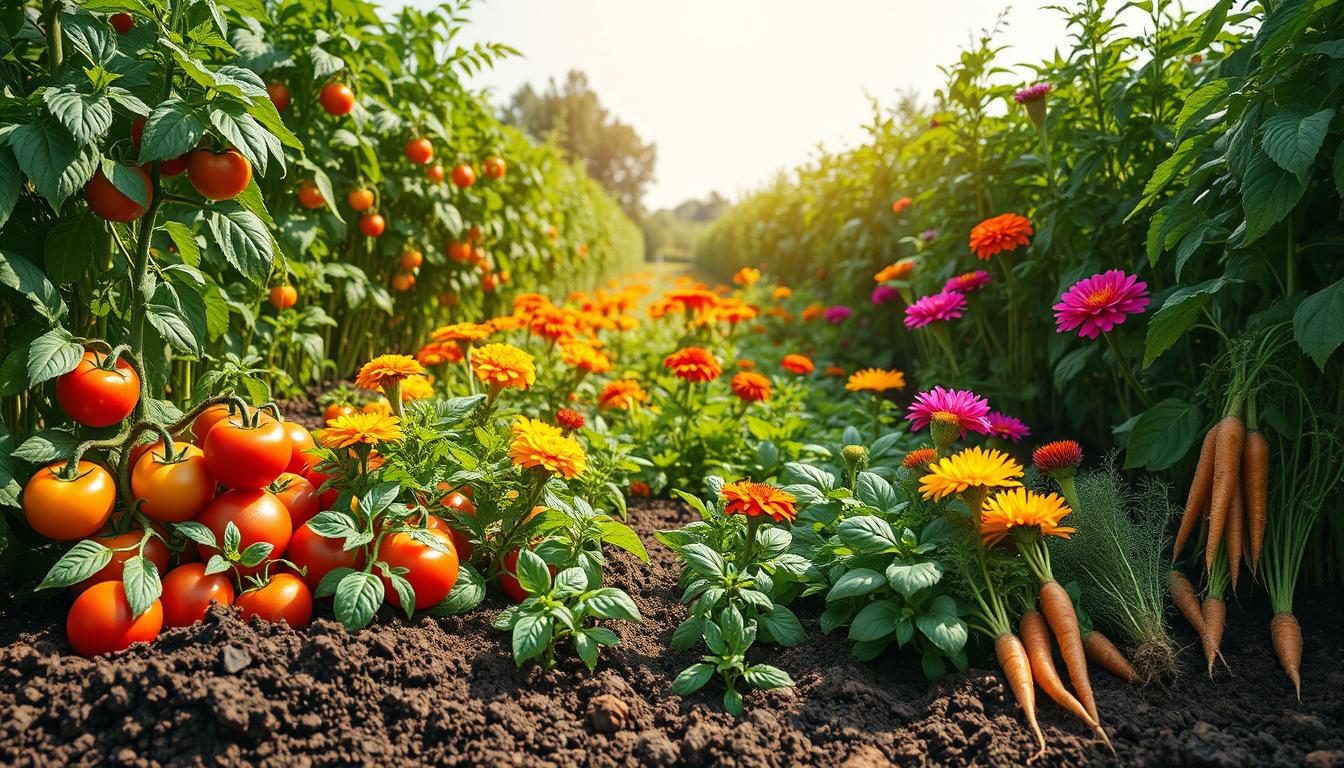Welcome to my comprehensive companion planting guide. Here, I share my knowledge on creating a thriving garden. You’ll learn the best plant combinations for successful companion planting. This guide will help you grow a bountiful and low-maintenance garden using organic methods.
I’ll cover the basics of companion planting. I’ll also give you tips on creating a successful plan. This way, you can start your own companion planting guide and enjoy the benefits of organic planting.
Whether you’re a seasoned gardener or just starting out, this guide is for you. It will help you understand the importance of companion planting. You’ll learn how to apply it in your garden for a thriving and healthy harvest.
What is Companion Planting?
Companion planting is a fascinating gardening technique. It involves growing different plants together to boost their health and growth. This method helps gardeners create a balanced ecosystem where plants thrive.
By understanding companion planting, gardeners can improve soil health and increase crop yields. They also reduce pest and disease problems. It’s a way to make gardening more sustainable and effective.
Companion planting makes gardens diverse and resilient. By pairing vegetables, herbs, and flowers, gardeners can avoid using harmful chemicals. For instance, marigolds can keep nematodes away from tomatoes, while basil enhances lettuce’s flavor.
Understanding the Concept
To get the most from companion planting, knowing how plants interact is key. Some, like beans and corn, support each other. Others, like tomatoes and basil, repel pests or improve taste.
By understanding these relationships, gardeners can design the best companion planting plan for their garden. This ensures a harmonious and productive growing space.
Benefits of Companion Planting
Companion planting offers many advantages. It improves soil health, boosts crop yields, and reduces pests and diseases. It also makes gardens more sustainable by reducing the need for harmful chemicals.
Other benefits include better air circulation, attracting beneficial insects, and enhancing the taste and texture of produce. These advantages make companion planting a valuable gardening technique.
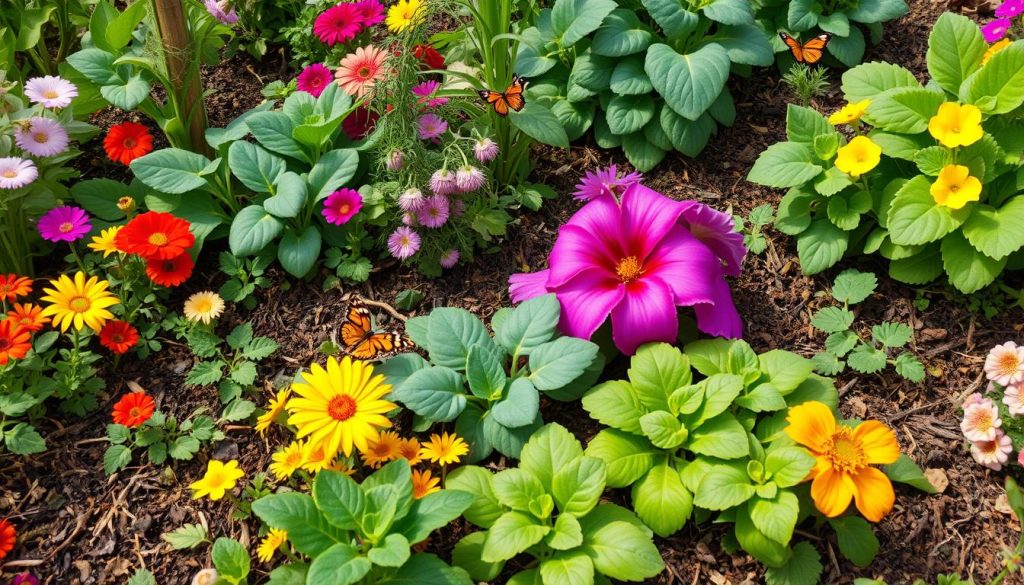
By following these tips and using a companion planting chart, gardeners can create a thriving garden. This garden promotes healthy plant growth and reduces the need for harmful chemicals.
How Companion Planting Works
I’m really interested in how different plants work together in a garden. By learning about these interactions, I can make my garden full of life. Planting vegetables, herbs, and flowers together can really help my garden grow better.
Some plants, like marigolds and nasturtiums, keep pests away. This helps plants like tomatoes and carrots grow well. Herbs like basil and mint can also make nearby plants taste and smell better.
The Science Behind It
Companion planting is based on how plants talk to each other through chemicals. For example, marigolds release chemicals that keep nematodes and other pests away when planted with vegetables.
Pest Control Benefits
One big plus of companion planting is it helps control pests naturally. By growing herbs like basil and mint with vegetables, I can use fewer pesticides. This makes my garden a healthier place. Here are some good pairs for pest control:
- Marigolds and tomatoes: repel nematodes and other pests
- Nasturtiums and cabbage: repel aphids and whiteflies
- Basil and peppers: improve flavor and repel pests
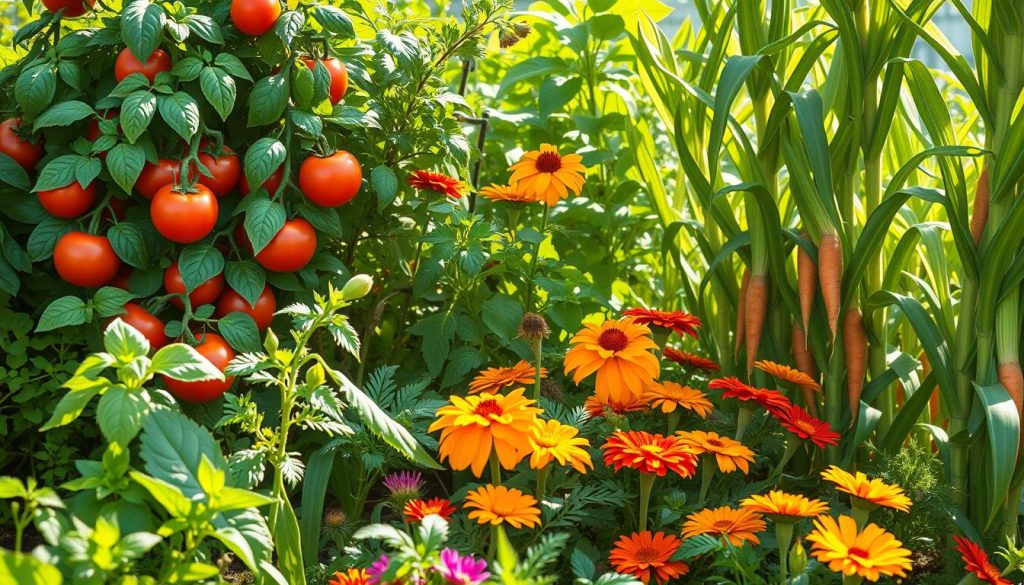
Best Companion Plants for Vegetables
Many vegetable combinations can boost growth and fight pests. Gardeners use tips and charts to create diverse gardens. This makes their gardens thrive.
Tomatoes and Basil
Tomatoes and basil are a favorite pair. Basil keeps pests away from tomatoes. It also makes tomatoes taste better. This shows how planting together can improve vegetables.
Carrots and Onions
Carrots and onions work well together. Onions keep rabbits and deer away from carrots. Carrots also help onions grow better. This shows the value of planting wisely.
Beans and Corn
Beans and corn are another great team. Beans add nitrogen, which helps corn. Corn also shades and supports beans. This is a perfect example of a productive garden.
Using these pairs and a chart can make a garden diverse and productive. Always follow tips for the best results.
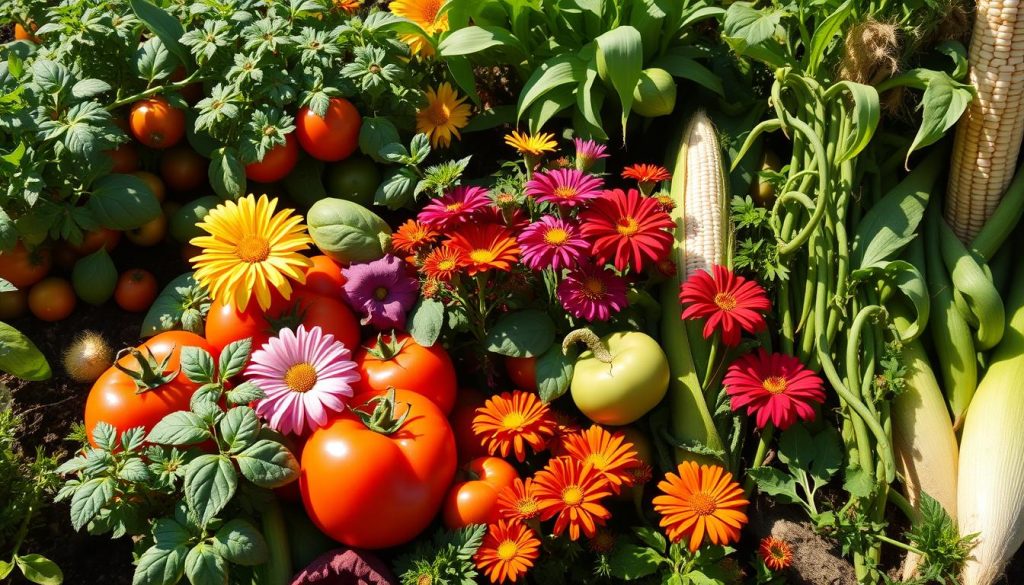
| Vegetable | Companion Plant | Benefits |
|---|---|---|
| Tomatoes | Basil | Pest repellent, improved flavor |
| Carrots | Onions | Pest repellent, improved growth |
| Beans | Corn | Nitrogen provision, shade and support |
Flowers That Help Your Garden Thrive
I’m excited to share how flowers can make your garden better. Companion planting flowers help create a balanced garden. Organic methods lead to great results.
Marigolds and nasturtiums are top choices for companion planting. They’re not just pretty; they also help your garden. Here’s why you should add them:
Marigolds: A Natural Pest Repellent
Marigolds keep pests like nematodes away from your veggies. They’re simple to grow and pair well with many vegetables. They’re a must-have for any garden.
Nasturtiums: Attracting Beneficial Insects
Nasturtiums draw good bugs to your garden. They’re perfect for attracting beneficial insects like lacewings and hoverflies.
Here are some tips for using these flowers in your garden:
- Plant marigolds and nasturtiums with your veggies for a balanced garden
- Use different flowers to attract good bugs and keep pests away
- Try organic methods for the best companion planting results
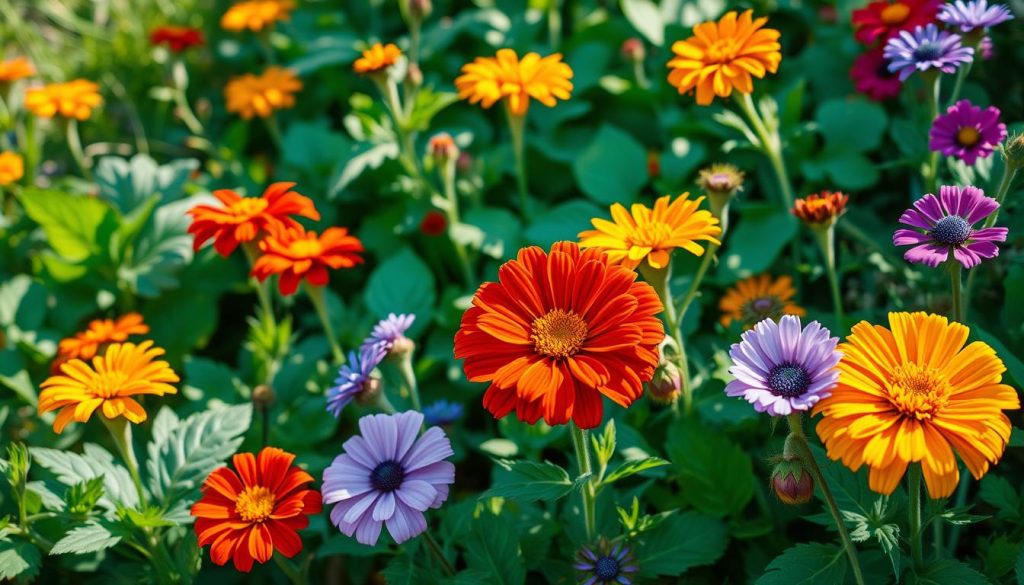
Creating a Companion Planting Plan
To get the most out of companion planting, you need a good plan for your garden. Start by looking at your garden space and grouping plants that go well together. This way, you can make your garden flourish. A good guide will show you which plants are friends and how to arrange them.
When planning, think about what each plant needs, like sunlight, water, and soil. This helps you put plants with similar needs together. For example, tomatoes, basil, and carrots like the same growing conditions. By following simple tips, you can make a garden that works well together.
Here are some steps to follow when creating a companion planting plan:
- Look at your garden space and find the sunniest and best soil areas.
- Pick the plants you want and group them by their growing needs.
- Think about how big each plant will get and leave enough space for them.
By following these steps and using a good guide, you can make a garden that’s beautiful and productive. It will thrive for many years.
Seasonal Companion Planting Tips
When I plan my garden, I think about the season and the best planting strategies. Using companion planting for vegetables, herbs, and flowers makes my garden diverse and thriving.
In spring, I plant combinations that repel pests and attract good insects. For instance, marigolds with tomatoes and carrots can keep nematodes away.
Spring Planting Combinations
- Tomatoes and basil: a classic combo that boosts flavor and keeps pests away
- Carrots and sage: this pair improves growth and taste
- Radishes and cucumbers: they help fight cucumber beetles
Fall Planting Strategies
In fall, I plant herbs and flowers that attract beneficial insects and improve soil. Nasturtiums and calendula, for example, draw good bugs and enrich the soil.
These seasonal tips help my garden fight pests and diseases better. Whether it’s vegetables, herbs, or flowers, I’m making a healthy garden. It will give me fresh produce for many months.
Common Mistakes in Companion Planting
Exploring companion planting, I’ve learned that mistakes can occur. A good companion planting guide is key to success. Knowing common pitfalls helps in organic gardening.
One big mistake is planting incompatible plants together. Some plants don’t get along, which can slow their growth. For instance, broccoli and cauliflower shouldn’t be near tomatoes and peppers.
Planting Incompatibilities
- Failing to research plant compatibility
- Ignoring growth patterns and space requirements
- Not considering the mature size of plants
Another mistake is ignoring growth patterns. Plants grow differently, and not planning for this can cause overcrowding. Knowing your plants’ growth habits helps in choosing the right companions.
Neglecting Growth Patterns
To avoid these mistakes, research and plan your garden carefully. With knowledge and patience, you can have a beautiful, productive garden. Use successful companion planting and a good guide.
Using Companion Planting with Herbs
I’ve been exploring companion planting and found many benefits with herbs in my garden. Herbs can make vegetables grow better and taste sweeter. They also keep pests away and attract good bugs. Pairing herbs with vegetables is a great way to use them.
Basil and peppers are a great team. Basil makes peppers taste better and keeps pests like aphids away. Mint and cabbage also work well together. Mint keeps cabbage moths off and makes cabbage grow better.
Here are some tips for using herbs in your garden:
- Plant basil with tomatoes and peppers to improve flavor and repel pests
- Use mint to repel cabbage moths and other pests that target brassicas
- Plant dill with cucumbers and squash to improve growth and flavor
Using herbs in my garden makes it more diverse and healthy. It needs less chemicals and fertilizers. Choosing the right plants together is key. With some planning, my garden can thrive.
By trying different herb and vegetable pairs, my garden can reach its full potential. I’ll enjoy a harvest full of fresh, tasty food.
| Herb | Vegetable | Benefits |
|---|---|---|
| Basil | Peppers | Repels pests, improves flavor |
| Mint | Cabbage | Repels cabbage moths, improves growth |
| Dill | Cucumbers | Improves growth, repels pests |
Maintaining Your Companion Garden
To keep your companion garden healthy, follow a guide and use good planting techniques. This way, you’ll have a balanced garden that grows well and fights off pests and diseases.
Regular Monitoring
Checking your garden daily is key. Look for signs of stress, disease, or pests. Catching problems early helps stop them from getting worse.
Adjusting Planting Strategies
Watching your garden means you might need to change how you plant. Here are some tips:
- Keep a record of your plantings and note what works well together
- Be prepared to move plants to different locations if necessary
- Consider adding new plants to your garden to attract beneficial insects or repel pests
By following these tips and using a guide, your garden will thrive. It will need little care and will be organic.
Resources for Further Learning
Exploring companion planting has opened up a world of gardening knowledge for me. I’ve found many resources, from books to online forums, that have enhanced my gardening skills. These resources help me learn more about companion planting and connect with fellow gardeners.
Books are a great way to dive into companion planting. Favorites of mine include “The Companion Planting Guide” and “Vegetable Companion Planting: A Guide to Growing Healthy Vegetables”. These books offer valuable tips and insights into using a companion planting chart for garden planning.
Books on Companion Planting
- The Companion Planting Guide” by a renowned gardening expert
- “Vegetable Companion Planting: A Guide to Growing Healthy Vegetables” by a well-known horticulturist
Online Communities and Forums
Online forums are also excellent for learning about companion planting. Sites like Gardening Forum and Companion Planting Forum are great places to ask questions and share experiences. You can get advice from seasoned gardeners on vegetable companion planting.
Using these resources can deepen your understanding of companion planting. Whether you’re new to gardening or have experience, there’s always more to learn. With the right tools, you can create a vibrant garden using companion planting tips and charts.
My Personal Companion Planting Success Stories
As I’ve shared in thiscompanion planting guide, a thriving garden comes from plants working together. I’m thrilled to share my own success stories. They show the strength oforganic companion planting.
Thriving Tomatoes and Basil Partnership
Planting tomatoes with basil is a favorite of mine. The basil boosts tomato flavor and keeps pests away. Aphids and whiteflies don’t stand a chance against it.
Seeing my tomato plants grow strong with basil’s help is amazing. It’s a natural way to keep pests off.
Overcoming Pest Problems with Marigolds
I used to fight cucumber beetles and other pests in my garden. But withsuccessful companion planting, marigolds have been a game-changer. Their scent keeps bugs away.
This lets my cucumbers, squash, and other veggies grow well. No need for chemicals here.
Companion planting has made my garden vibrant and organic. It needs less care and gives me plenty to harvest. I hope my stories encourage you to try it in your garden too.

